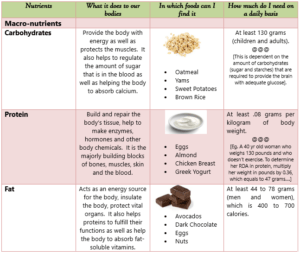

Foods like butter, cream cheese, full-fat dairy products, animal fats, and fried foods are also considered fats however, they should be limited. The best fats come in vegetable oils (like olive oil or avocado oil), fish like salmon or tuna, avocados, flax seeds, chia seeds, and nuts. FatsĮxperts recommend that 20 to 35% of your daily calories should come from fat. Processed foods such as bacon, lunch meat, and hotdogs are also high in protein content, but they should be limited. Examples of foods with high protein content include lentils, beans, tofu, tempeh, nuts, whole grains, and animal protein. Proteins are also critical for enabling the cells of your body to communicate with each other. Protein can be broken down for-such as creating cell membranes, tendons, ligaments, hair, and nails. ProteinĮxperts recommend that 10 to 35% of your daily calories come from protein. Processed foods such as crackers, bread, cereals, desserts, fruit juices, and sodas are also considered carbohydrates, but they are processed differently by your body and should be limited.

Examples of complex carbohydrates include whole grains, vegetables, fruits, beans, lentils, peas, and dairy products.

Good sources of carbohydrates are known as “complex” carbohydrates, which means that they have a chemical structure that breaks down more slowly because of the presence of fiber. Carbohydrates provide a quick source of energy for your brain and muscles, and they are used up first when you are exercising and performing other tasks. CarbohydratesĮxperts recommend that 45 to 65% of your daily calories come from carbohydrates. Here is the recommended macronutrient breakdown for the average person (if you have specific health conditions, your macronutrient needs may vary-make sure to check in with your medical provider about your personal nutritional needs). On the other hand, a spoonful of olive oil is exclusive of fats.Įxperts create dietary recommendations based on macronutrients because they are your body’s primary energy sources. For example, a cucumber is primarily a carbohydrate with a bit of protein content. All of your daily food can be described based on its macronutrient profiles. There are three dietary macronutrients: protein, carbohydrates, and fat. What is a Macronutrient?Ī macronutrient describes a category of food molecules with a specific chemical structure. Here’s what you need to know about the nutritional categories of macronutrients and micronutrients and why they matter. And, as the saying goes, food is medicine-being deliberate about what you’re eating every day can have positive ripple effects over the long term. Your diet, defined as what you eat daily, is a critical component of your lifestyle.

You’ve probably become accustomed to hearing phrases such as “carbohydrate content” and “grams of protein.” Still, you may not be aware of why these characteristics are vital for your daily food intake.Īt Lompoc Valley Medical Center, we have a mission to keep our patients healthy and living well-and that starts with education about all health and nutritional matters. When was the last time you examined a nutrition label on the side of a packaged food item? If you did so recently, you would have noticed a breakdown of the contents of your food, organized into the categories of macronutrients and micronutrients. Not all food is created equal, and getting a good balance of macronutrients and micronutrients is an essential part of eating a healthy diet.


 0 kommentar(er)
0 kommentar(er)
